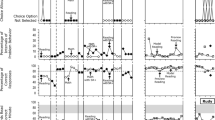Abstract
This study presents initial standardization data on the Sutter- Eyberg Student Behavior Inventory (SESBI), a teacher- completed measure of disruptive classroom behaviors. SESBIs were completed on 1116 children in kindergarten through fifth grade in a rural eastern Washington school district. Various analyses (Cronbach's alpha, corrected item- total correlations, average interitem correlations, principal components analyses) indicated that the SESBI provides a homogeneous measure of disruptive behaviors. Support was also found for three factors within the scale (e.g., overt aggression, oppositional behavior, and attentional difficulties). While the child's age did not have a significant effect on the SESBI, the child's gender did have a significant effect on scale scores as well as on most of the items, with males being rated more problematic than females. The SESBI was also able to discriminate between children in treatment for behavioral problems or learning disabilities and children not in treatment.
Similar content being viewed by others
References
American Psychiatric Association. (1987).Diagnostic and statistical manual of mental disorders (3rd ed., rev.). Washington, DC: Author.
Burns, G. L., & Patterson, D. R. (in press). Conduct problem behaviors in a stratified random sample of children and adolescents: New standardization data on the Eyberg Child Behavior Inventory.Psychological Assessment: A Journal of Consulting and Clinical Psychology.
Burns, G. L., Patterson, D. R., Nussbaum, B., & Parker, C. (in press). Conduct problem behaviors in an outpatient pediatric population.Psychological Assessment: A Journal of Consulting and Clinical Psychology.
Funderburk, B. W., & Eyberg, S. M. (1989). Psychometric characteristics of the Sutter-Eyberg Student Behavior Inventory: A school behavior rating scale for use with preschool children.Behavioral Assessment, 11, 297–313.
Harpur, T. J., Hare, R. D., & Hakstian, A. R. (1989). Two factor conceptualization of psychopathy: Construct validity and assessment implications.Psychological Assessment: A Journal of Consulting and Clinical Psychology, 1, 6–17.
Ladish, C, Sosna, T. D., Warner, D., & Burns, G. L. (1989), August). Psychometric properties of the Sutter-Eyberg Student Behavior Inventory in a preschool sample. In G. L. Burns (Chair),SESBI: A teacher rating scale of conduct problem behavior. Symposium presented at the 97th annual meeting of the American Psychological Association, New Orleans.
Mash, E. J., & Terdal, L. G. (Eds.). (1988).Behavioral assessment of childhood disorders (2nd ed.). New York: Guilford.
McMahon, R. J., & Forehand, R. (1988). Conduct disorders. In E. J. Mash & L. G. Terdal (Eds.),Behavioral assessment of childhood disorders (2nd ed., pp. 105–153). New York: Guilford.
McMahon, R. J., & Wells, K. C. (1989). Conduct disorders. In E. J. Mash & R. A. Barkley (Eds.),Treatment of childhood disorders (pp. 73–132). New York: Guilford.
Milligan, G. W., Wong, D. S., & Thompson, P. A. (1987). Robustness properties of nonorthogonal analysis of variance.Psychological Bulletin, 101, 464–470.
Sutter, J., & Eyberg, S. M. (1984).Sutter-Eyberg Student Behavior Inventory. Gainesville, FL: Authors. (Available from Sheila Eyberg, Department of Clinical and Health Psychology, University of Florida, Gainesville, FL 32610.)
Webster-Stratton, C. (1988). Mothers' and fathers' perceptions of child deviance: Roles of parent and child behaviors and parent adjustment.Journal of Consulting and Clinical Psychology, 56, 909–915.
Webster-Stratton, C, Kolpacoff, M., & Hollinsworth, T. (1988). Self-administered videotape therapy for families with conduct problem children: Comparison with two cost-effective treatments and a control group.Journal of Consulting and Clinical Psychology, 56, 558–566.
Welkowitz, J., Ewen, R. B., & Cohen, J. (1976).Introductory statistics for the behavioral sciences (2nd ed.). New York: Academic Press.
Author information
Authors and Affiliations
Additional information
The authors would like to acknowledge the support of the teachers in the Pullman School District, whose kind help and assistance made the study possible. Special thanks are also extended to Todd Sosna, Christine Ladish, and Lee Sternberger for their helpful comments on earlier versions of the paper. Preparation of this study was supported in part by funds provided to G. Leonard Burns by Washington State University.
Rights and permissions
About this article
Cite this article
Burns, G.L., Owen, S.M. Disruptive behaviors in the classroom: Initial standardization data on a new teacher rating scale. J Abnorm Child Psychol 18, 515–525 (1990). https://doi.org/10.1007/BF00911105
Revised:
Issue Date:
DOI: https://doi.org/10.1007/BF00911105




